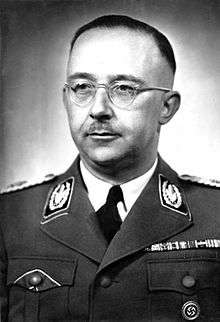Gudrun Burwitz
| Gudrun Margarete Elfriede Emma Anna Burwitz | |
|---|---|
 Gudrun Himmler with her mother at the Nuremberg trials, 1945. | |
| Born |
Gudrun Himmler 8 August 1929 Munich, Bavaria, Germany |
| Nationality | German |
| Other names | Püppi |
| Known for | daughter of Nazi Reichsführer-SS Heinrich Himmler |
| Spouse(s) | Wulf Dieter Burwitz |
| Children | 2 |
| Parent(s) |
|
| Relatives |
|
Gudrun Margarete Elfriede Emma Anna Burwitz (born Himmler, 8 August 1929) is the daughter of Heinrich Himmler, Reichsführer-SS, leading member of the Nazi Party (NSDAP), and chief architect of the Final Solution.[1] After the allied victory, she was arrested and made to testify at the Nuremberg trials. Having never renounced Nazi ideology, she has consistently fought to defend her father’s reputation, and has become closely involved in Neo-Nazi groups that give support to ex-members of the SS. She married Wulf Dieter Burwitz, an official of the far-right NPD.
Relationship with her father


Gudrun Himmler is the daughter of Heinrich Himmler, Reichsführer-SS, Chief of Police and Security forces, and Reich Minister of the Interior in Nazi Germany. She was the only child of Himmler and his wife Margarete Siegroth, née Boden,[3] though her parents later adopted a son. (Himmler also had two children with his secretary, Hedwig Potthast.[4]) Gudrun was born in Munich and baptised a Protestant.
Heinrich Himmler adored his daughter and had her regularly flown to his offices in Berlin from Munich where she lived with her mother.[5] When she was at home he telephoned her most days and wrote to her every week. He continued to call her by her childhood nickname "Püppi" throughout his life.[6] She accompanied her father on some official duties.
She disputed that Heinrich Himmler, who died in British captivity on 23 May 1945, took his own life by breaking a concealed cyanide capsule, claiming that he was murdered.[5] After the Second World War she and her mother were arrested by the Americans and held in various camps in Italy, France and Germany. They were brought to Nuremberg to testify at the trials, and were released in November 1946.[7] Gudrun later bitterly referred to these years as the most difficult of her life, and said that she and her mother were treated as though they had to atone for the sins of her father.[5]
She has never renounced the Nazi ideology and has repeatedly sought to justify the actions of her father, relative to the context of his time. People who know her say that Gudrun has created a "golden image" of her father.[8]
Nazi sympathies
She married the journalist and author Wulf Dieter Burwitz, who would become a party official in the Bavarian section of the far-right NPD,[3] and had two children. She is affiliated with Stille Hilfe, an organization formed to aid former SS members, which assisted Klaus Barbie of the Lyon Gestapo and Martin Sommer, otherwise known as the "Hangman of Buchenwald", and "continues to support a Protestant old people's home in Pullach, near Munich".[9]
For decades Gudrun Burwitz has been a prominent public figure in Stille Hilfe. At various meetings, for instance the annual Ulrichsberg gathering in Austria, she receives the status of both a star and an authority. Oliver Schröm, author of a book about Stille Hilfe, has described her as a "flamboyant Nazi princess" ("schillernde Nazi-Prinzessin").[10]
Gudrun Burwitz has intensified the support for alleged Nazi war criminals in recent years.[8]
Notes
- ↑ Browning, Christopher R. (2004). The Origins of the Final Solution: The Evolution of Nazi Jewish Policy, September 1939 – March 1942. Comprehensive History of the Holocaust. Lincoln: University of Nebraska Press. pp. 36–110. ISBN 0-8032-1327-1.
- ↑ Longerich 2012, p. 467.
- 1 2 Kelerhoff, Sven Felix; Meyer, Simone; Schuster, Jacques; Schuster, Ulrich (2014-02-01). "Himmlers Nachwuchs". Welt Online (in German). Retrieved 2015-04-30.
- ↑ Andersen 2007, p. 165.
- 1 2 3 Helm, Siegfried (1998). "Himmlers Tochter hilft den alten Gefährten". Berliner Morgenpost (in German). Retrieved 5 October 2008.
- ↑ Longerich 2012, p. 468.
- ↑ Katrin Himmler, The Himmler Brothers, Pan Macmillan, 2012, p.275.
- 1 2 Sanai, Darius (1999). "The sins of my father". The Independent (London). Retrieved 5 October 2008.
- ↑ Pike 2000, p. 380.
- ↑ Fabian Leber: Gudrun Burwitz und die „Stille Hilfe“: Die schillernde Nazi-Prinzessin; in: Der Tagesspiegel, 10 June 2001 (In German)
References
- Andersen, Dan H. (2007). Nazimyter—blodreligion og dødskult i Det Tredje Rige (in Danish). Aschehoug. ISBN 978-87-11-11847-4.
- Lebert, Norbert, and Stephan. Denn Du trägst meinen Namen: das schwere Erbe der prominenten Nazi-Kinder. Goldmann Verlag 2002, ISBN 3-442-15188-0 (in German)
- Lebert, Norbert, and Stephan. My Father's Keeper: Children of Nazi Leadership: An Intimate History of Damage and Denial, translated by Julian Evans. New York: Little, Brown, 2001. ISBN 0-316-51929-4
- Longerich, Peter (2012). Heinrich Himmler: A Life. Oxford; New York: Oxford University Press. ISBN 978-0-19-959232-6.
- Pike, David Wingeate (2000). Spaniards in the Holocaust: Mauthausen, the Horror on the Danube. London: Routledge.
- Schröm, Oliver and Andrea Röpke. Stille Hilfe für braune Kameraden. Christoph Links Verlag, Berlin 2001, ISBN 3-86153-231-X (in German)
